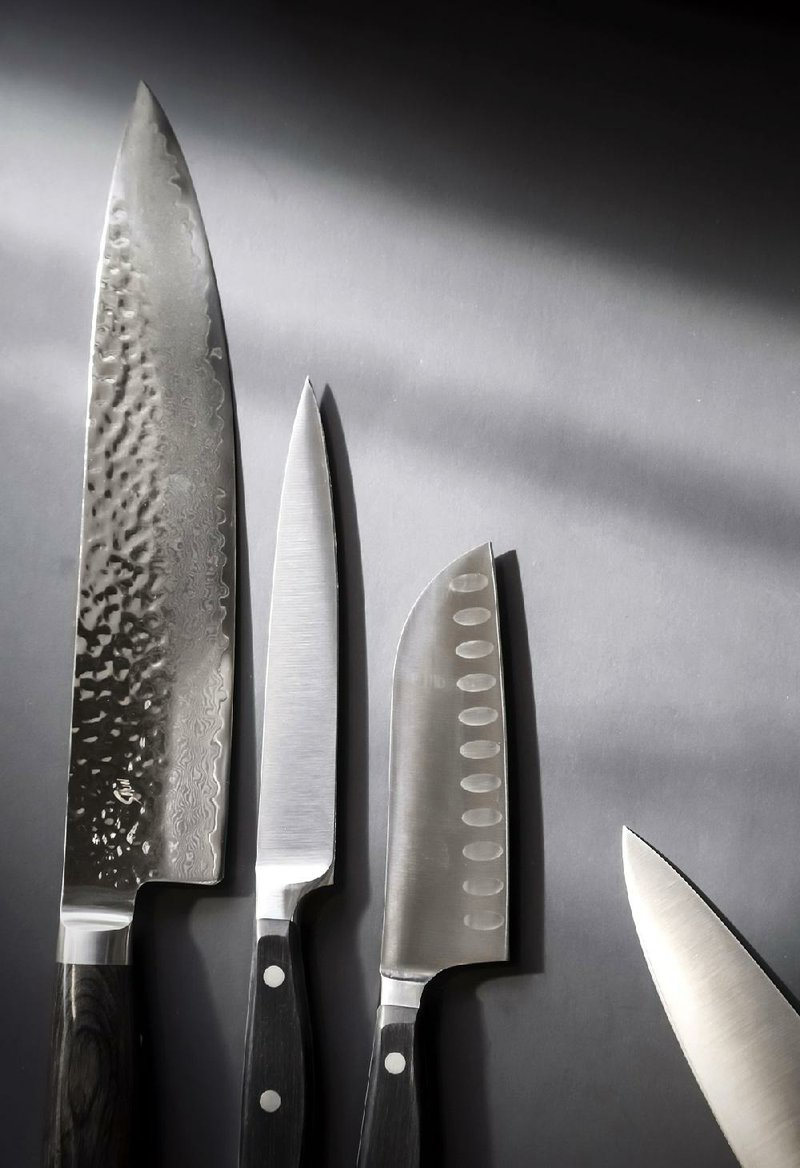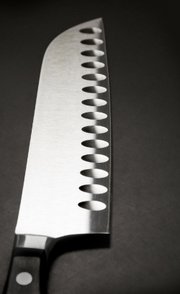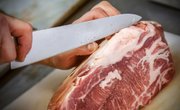The right tools can go a long way in making life a little easier. Take the simple kitchen knife, for example.
"If you have a knife that's hard to use, that's not cutting properly, you get frustrated and associate cooking with not being a fun time," says Susanna Escobar of Eggshells Kitchen Co. in Little Rock. "If you're not going to war with your onion, you might actually enjoy making salsa or slicing onions for a fajita."
Right? Who wants to go to war in the kitchen, especially with some dull old knife? A good knife will slice or dice that onion -- or squash or bell pepper or slab of beef -- right up and will be ready to tackle the next task, making cooking more of a good time and less of a stressful, I-don't-want-to-do-this experience.
"If you're not frustrated, you can enjoy your time," says Escobar as she and co-worker Cynthia Wyman talk about how using proper knives can help the average cook, and they're not talking about the ones that can cut through a soda can on TV.
"The most important knives would be the chef's knife and the santoku," says Wyman, who graduated from Pulaski Technical College Culinary Arts and Hospitality Management Institute in 2014 and gives knife demonstrations at Eggshells, of her preferences.
The chef's knife, or cook's knife, may be what comes to mind most often when thinking of a kitchen blade. Ranging from 6 to 10 inches, the chef's knife is often the go-to tool for cooks looking to chop vegetables or cut into a hunk of meat. Its blade, like many good knives, is usually made of a mixture of stainless steel, carbon steel and other alloys to give it strength and durability. Ceramic blades in varying lengths are also common.
"You don't want to buy a knife that is just stainless steel," Escobar says. "Those tend to go dull very quickly. They also have the potential for rust spots."
The santoku, ideal for chopping and dicing, is straighter with a rounded tip, is usually 5 to 8 inches long, and often has a divots along the blade to help prevent watery produce from sticking to it.
"I will use the santoku nine times out of 10 at my house," Wyman says.
Billy Ginocchio, chef and faculty member at Pulaski Tech, says a chef's knife and a short paring knife with a 3 1/2- to 4-inch blade can handle just about any kitchen job.
"You can do 100 percent of your cutting at home with these two knives," he says in one of the gleaming kitchen classrooms at Pulaski Tech. A 9-inch chef's knife, though sometimes hard to find, is the most versatile, he says, but the 8-inch version is also good.
A super slicer, which can do a little bit of everything, is a favorite of Escobar's.
"It's beveled on one side and is great for shaving meat and slicing," she says, showing one made by German knife maker Wusthof. "I use it for citrus and it also works as a bread knife. It's thin, easy to use, lightweight. It's also great for sandwich prep."
Brandon Brown, owner of Hillcrest Artisan Meats in Little Rock, certainly knows how to handle a blade. His chef's knife and boning knife get the most use at his restaurant and butcher shop, where for five years he has served artisan meats and charcuterie products (HAM will close at the end of the year after Brown sold the business to Tomas Bohm of The Pantry and The Pantry Crest).
"These are the ones that are most important to us around here," Brown says as he sorts through the array of chef's knives behind the counter at HAM, where the smell of smoked meat is like a carnivore's heaven.
The light, thin boning knife is unique in that most of them bend to make close cuts easier.
"They're super flexible so you can get in and get around a bone," Brown says.
There are also knives with serrated edges used for cutting bread. "We cut tomatoes with those, too," Brown adds.
Brown's preferred chef's knife is made by Global and is light and sleek.
"It's such a personal preference," he says. "I like Globals just because they seem to hold an edge really well and they're light." Using a knife all day isn't like swinging a heavy hammer, he says, but a little additional weight can add up.
The heft and balance of a knife is just as important for home cooks, Escobar says.
"A lot of people say, 'Give me the biggest chef's knife you've got,' but when you start holding it, it can feel weird."
Most good kitchen stores will allow the customer to handle the knife before buying, Escobar says.
"Also, when buying, you want to make sure that the metal goes all the way through," Wyman says as she shows how the blade of a Wusthof brand chef's knife is one piece and part of the handle. "That means it's sturdy and won't break at the handle" as a two-piece knife could.
A good knife is not cheap. A small Wusthof paring knife starts about $49. A Wusthof chef's knife starts about $99 and can creep up to nearly $200, depending on size. Custom-made chef's knives can cost more than $300.
At Eggshells, Wyman and Escobar show off a gorgeous chef's knife made by Shun with a wooden handle and a Damascus, layered-steel blade, which costs $179.
No need to freak over the price of a kitchen full of expensive knives, though.
"If you're on a smaller budget, if you're just starting out cooking, or if you're looking to upgrade, it's probably best to do one knife at a time instead of buying a full set," Escobar says. "Start with a chef's knife and expand from there."
Also, a well-made knife is pretty bulletproof. Brown still uses a $130 chef's knife he got as a gift 15 years ago.
"The thing is, if you buy a good knife, it'll last you forever," he says.
If, of course, the knife receives a little love.
High-end knives tend to hold their sharpness longer, but sharpening is still required from time to time.
A sharp knife should cut anything as if it were slicing through butter, Escobar says. Anything less and it's sharpening time.
There are a couple of different approaches to sharpening a knife. The easiest is with a pull-through sharpener, which has an angled ceramic sharpener inside and is used by simply pulling the knife through a few times until it's sharp.
And then there is the whetstone, the proper use of which can be difficult to master but the results bring an exquisite edge.
"I'm horrible at sharpening," Brown confesses. "It's definitely an art."
Natural Arkansas Stones are popular among many knife-sharpening aficionados and are made from novaculite quarried here.
"I use an Arkansas three-way stone," Wyman says. Moistening the stone with a bit of vegetable oil, she holds the knife at a 20-degree angle and slides it across the stone, making that distinctive scraping sound of steel on rock, an equal amount of times for each side of the blade.
And the irony is that a sharp blade is safer than a dull one.
"Dull knives are dangerous," Ginocchio says. "The reason that they're dangerous is because you've got to apply so much more force to make the cut. If anything slips and you're applying that much force, then you're going to have a much worse cut than with a sharp knife."
You know those rods with the handle that it seems every chef in a movie or television show is quickly and dramatically dragging a knife across? That's called a steel, which is more for maintaining the edge rather than sharpening.
"All knives have microscopic teeth. The steel realigns those," Wyman says.
"Always hone your knives before you use them" with a steel, Ginocchio says. Alternate sides to avoid knocking the teeth out of balance and keep the knife at at 20-degree angle when sliding across the steel, he adds. "It doesn't take 50 bazillion strokes. It takes, like, a half dozen on each side."
Other than maintaining the edge, caring for your sharp, somewhat expensive knives is actually pretty simple. Wash with warm water and soap and dry with a clean towel, paper towel or just let them air dry and put them away, say Escobar and Wyman. Avoid the dishwasher, however, except on rare occasions.
Ceramic knives are dishwasher safe, cheaper than steel and don't need sharpening nearly as much (if at all), but they are breakable and won't cut it on tougher items like rutabagas and sweet potatoes, Wyman says.
"I wouldn't recommend one for someone just starting their culinary journey," Escobar says. "But if you've been cooking for a while and you're looking for something new, they are a great alternative to add to your collection."
Food on 12/21/2016


